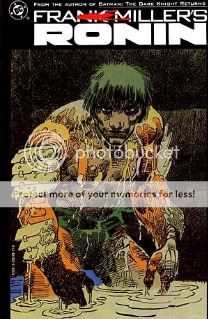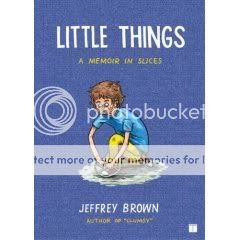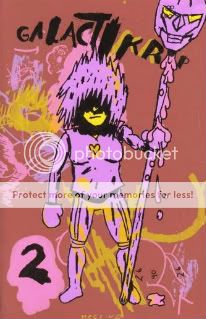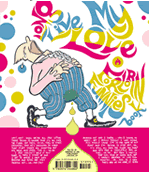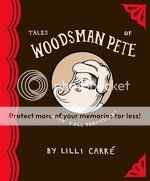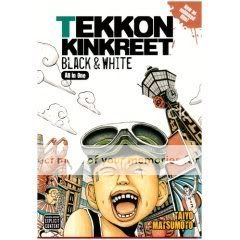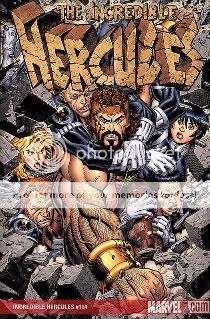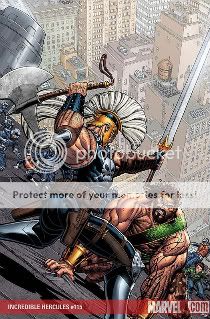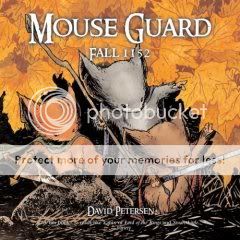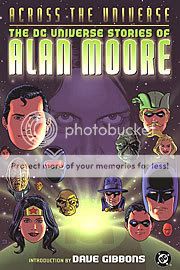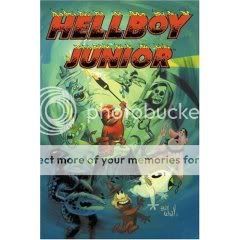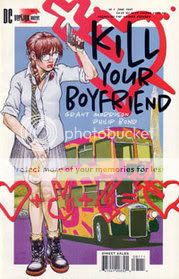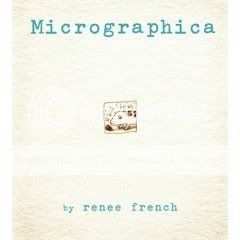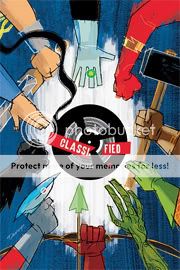Posts Tagged ‘comics reviews’
Comics Time: Ronin
April 25, 2008Ronin
Frank Miller, writer/artist
DC, 1984
302 pages
$19.99
If The Dark Knight Strikes Again is Frank Miller’s brain on SPX, I suppose Ronin is Frank Miller’s brain on Shogun Assassin. I’d say Lone Wolf and Cub proper or some other manga touchstone, but the thing is that my own comparative ignorance of Japanese comics and Miller’s enormous influence on Western ones make it hard for me to see evaluate this formally as anything but a Frank Miller Comic that happens to use samurai and Akira-style science fiction.
It’s a very good Frank Miller Comic in fact. Back then his art had this doodly/sketchy quality—lots of little loops and bubbles and curlicues—that had yet to solidify into the hyperrealist noir of the first Sin City chapters in Dark Horse Presents and thence to recede to the chunky bigfoot self-satire of DKSA or the later Sin City books. It’s a bold style, perfect for conveying enormity by expanding the blobby details to the edge of the page or isolating action by stripping them away and letting the remaining figures slash through them. It’s also beautifully colored by Miller’s now ex-collaborator Lynn Varley; no one has used greens this effectively before or since.
Storywise it combines the familiar Japanese pulp tropes mentioned above with the uniquely Millerian idiom of topless black bondage Nazi gangs (cf. The Dark Knight Returns, Sin City), evil corporations painted with an hilariously broad satirical brush (cf. Hard Boiled), and sinister omnipotent female computer programs (cf. Martha Washington–man, if in some future FM Batman comic the Batcomputer ever gets referred to as “she,” watch out). But moreso than in any Miller comics save perhaps his collaborations with David Mazzuchelli, there’s a refreshing space left for the human element. While there’s obviously a lot of “he is the Hero, he is everything” to be found here, much of the plot is driven by the comparatively quotidian doings of the Aquarius Complex’s worker bees: middle management, staff psychiatrists, laborers pissed off at the treatment of the fellow workers, an idealistic scientist and his security-guard girlfriend whose story of success-driven estrangement would fit nicely into a late-’90s period piece about a dot-com startup. So it’s easy to forgive some narrative lapses, like a jarring bit of told-not-shown infodumping about how the ronin entered the modern world whose raison d’etre only becomes apparent at the end of the story, and simply focus on the pleasures of the art and the tempered-gonzo writing. Capping it all off is a brancinglysudden ending and final image of triumph-through-simply-existing that I really wish more genre comics would ape. I will enjoy rereading this comic every four years or so until I die.
Comics Time: Little Things
April 23, 2008Little Things
Jeffrey Brown, writer/artist
Touchstone/Simon & Schuster, March 2008
352 pages
$14
It had been a while since I read a full-length Jeffrey Brown comic starring Jeffrey Brown, and I’d forgotten what a unique experience a Jeffrey Brown autobio page is. Reproduced at roughly the same size at which they’re drawn, Brown’s pages are almost always stuffed with six square panels, which are themselves crammed with penned detail. But despite containing so much visual information, the casual feel of Brown’s line and portraiture make the page come across more mellow than manic. Meanwhile, and particularly when compared to the many other sketchy (by design or necessity) slice-of-life efforts that have sprung up in Brown’s wake, his pop-eyed characters pop from their backgrounds, which themselves feel like fully realized and inhabitable spaces. The total effect is really accomplished and unique, and it turns out I missed it quite a bit.
This is the part of the review where I was gonna argue that in these ways the art mirrors the story, or nonstory, presented in the book itself: a sea of detail saved from unpleasant obsessiveness by a breezily directionless presentation, against which notable specifics stand out. This observation has the virtue of being true, but I feel like reading that much into what’s going on sort of defeats the purpose of the book. While Brown argues in his introduction that the point is that tiny, seemingly insignificant moments–coffee with friends, awkward movie-watching experiences–can take on the same importance as truly life-changing events–gall-bladder surgery, witnessing a horrific car crash, meeting the father of the mother of your child–to me the book ultimately demonstrates something slightly but vitally different: Those insignificant moments remain insignificant, yet occupy a disproportionately high rank in our mental catalog of memories, and the resulting stew of momentousness and meaninglessness is in the end what makes our lives what they are. Both are indispensable.
Comics Time: Galactikrap 2
April 21, 2008Galactikrap 2
Brian Chippendale, writer/artist
self-published, October 2007
72 pages
$8
This is what those “fun” superhero comics that nobody but predominantly superhero-comics bloggers reads would look like in an alternate universe where Gary Panter took over as Marvel house artist instead of John Romita Sr. and Los Bros Buscema following the departures of Jack Kirby and Steve Ditko. The major difference, of course, is where in those books the action-humor blend is the primary selling point, here it’s simply the tool Chippendale uses to set up the action beats and environments that are the meat of his cartooning. The yuks and fights are the means to an end, not an end in themselves, but they also happen to be really really crackerjack, which is more than you can say about this book’s Big Two brethren.
Plotwise, this is a follow-up to Chippendale’s earlier Battlestack Galacti-crap, a story of two tribes (cue Frankie Goes to Hollywood) of costumed weirdoes battling it out over the right to sell cupcakes in a particular area of their sci-fi city. It’s exactly as nonsensical as it sounds, which is totally fine because the point is the drawing, and man, it’s a pip. This issue kicks off with a brief silkscreend color section that evokes the full-color openings of manga volumes, a comparison subverted here by the supreme ridiculous of the subject matter (one of our warring tribes, Teamy Weamy, is debating whether to change their name to Team Tomb or Team Tummy). The rest of the comic comprises three separate, vaguely interlocking vignettes, each defined by the way they use sequences of panels to pace action. In the first (back at the cupcake stand from the first issue) a bug-laden “bugcake” is lobbed past a stunned onlooker at the head of a disgruntled customer; Chippendale draws the action out over several panels to call attention to its kinetic silliness. This is in contrast to the next big bit, in which panel after panel is left silent while two characters are placed on hold as they call a credit card company to find out why one of their cards has been denied–here the drawn-out sequencing conveys boredom rather than action. Things kick into high gear in the second section, which involves a pair of super-types infiltrating an underground lair and battling robot-type dudes. Chippendale’s chunky, crunchy line is a surprisingly effective canvas for action choreography, making the space in which the action takes place feel solidly constructed and lived-in while lending a certain palpable oomph to various ninja stealth antics, laser dodges, and one really memorable blast at a bad guy. the third and final sequence is mainly an excuse to create a convenience store shaped like Godzilla called Snackzilla, I guess, but it too has a laugh-out loud depiction of slapstick involving a bunch of characters getting bonked on the head with a baseball bat and sent tumbling down a hole in the floor by a secret member of a rival gang. After a funny, deadpan two-page bonus comic by Ben Jones about a dog who will become the Chosen One but at this point mostly stands around with his tongue lolling out, the comic ends with another two-page color section; as with the first issue, this finale displays Chippendale’s knack for drawing figures in freefall, but this time uses it to set up a funny gag about one falling character remembering he can fly mid-plummet.
The character designs are all funny and easy to parse–I sort of want to see these folks cross over with the gang from Powr Mastrs; the environments, particularly in a trio of stand-alone pages toward the end of the book, are immersive and mysterious; and since Chippendale is working with basically one or two large panels per page it’s probably a lot easier than Ninja or Maggots for your average civilian to follow. This is the kind of minicomic you’ll read from cover to cover each time you come across it wherever you keep your minicomics. If you spot this at a con you should buy it.
Comics Time: Forlorn Funnies #5: My Love Is Dead/Long Live My Love
April 18, 2008Forlorn Funnies #5: My Love Is Dead/Long Live My Love
Paul Hornschemeier, writer/artist
Absence of Ink, 2004
80 pages
$10.95
Buy it from Copacetic Comics still, maybe
Originally written on July 8th, 2004 for publication in The Comics Journal
The fifth installment of Paul Hornschemeier’s personal anthology series is a transitional work of sorts, a midway point between the publication of the author’s formidable graphic novel Mother, Come Home (the serialized installments of which completely took over Forlorn Funnies‘ previous three issues) and his upcoming entrée into the art-comix big time when Fantagraphics begins publishing the series. (This is the alternative comics equivalent of a WB starlet getting that phone call from Playboy–you’ve made it, baby!) Perhaps Hornschemeier himself sensed the in medias res nature of this project. It’s his most direct effort to date in forging a middle way between his satirical and melancholy modes. Granted, separating the two physically may seem an odd way of linking them, but the link isn’t any less clear for that.
As the book’s subtitle suggests, My Love Is Dead/Long Live My Love is indeed divided into two sections, one “funny,” one “forlorn,” each printed at a 180-degree rotation from the other. Each section has its own “front cover” featuring the appropriate half of the subtitle and a mood-specific image and color scheme (as well as, cleverly, the book’s bar code and ISBN information–this way there’s now way to guess which half Hornschemeier considers “the back of the book”). At the spread at the center of the book, where the two sections meet, we find two pages’ worth of rival “About the Author” material, one of which solemnly enumerates Hornschemeier’s C.V. and the other of which features a lengthy explanation for its use of the phrase “butt smear.” (You’re all bright people, so I’ll leave it up to you to guess which is which.)
Baroque conceits such as this are nothing new for Hornschemeier–you may recall that the entirety of Mother, Come Home is supposed to be the introduction to a novel of which we only see the first chapter’s title page. It’s fun to watch Hornschemeier at play in the fields of the formal, but what excites one most about FF5 are the cartoonist’s visual and storytelling skills, which continue to expand at an alarmingly brisk rate.
Perhaps the best example of this is the emergence, fully formed, of a vocabulary of the monstrous a la Woodring or Brinkman. These strange creatures and the psychedelia-by-way-of-graphic-design wilderness in which they live are used to great effect on both sides of the forlorn/funny equation. In the former case (“Underneath”), a furry, Yeti-like behemoth responds to his growling stomach by diving under the sea, assaulting one of the creatures he finds there, and devouring one of the creature’s young as its sibling and parent look on. The attacker arrives back on dry land only for its stomach to rumble yet again; he glances at the sea, and in the subsequent panel is nowhere to be found. The sequence is wordless, the creatures expressionless, but the horror inherent in the sea-creatures inability to protect itself or its children is palpable and chilling. As it trundles over to comfort its surviving offspring when the land-creature swims away, we wonder what it can possibly say to provide solace or safety; moreover, when we realize the land-creature has gone back underwater, we know that neither is in the offing. The humiliating powerlessness of parents in the face of overwhelming violence is usually the subject of only the finest literature (on TV, only The Sopranos goes there; in comics, you’re hard pressed to find explorations of the topic outside historical efforts like Maus and Safe Area Gorazde); it’s both jarring and inspiring to see this painful aspect of human existence broached in a monster comic.
On the funny side of things (“Ditty and the Pillow Plane”), the monsters are used (not surprisingly, as we’ll soon see) to explore similar themes. While the two title characters float along in a manner reminiscent of Mother‘s opening sequence, strange creatures bite each other, ride each other, attempt to devour each other, and run past the frame while on fire. Ditty (whose eyes are x’s) and the Pillow Plane (who has no eyes to speak of) grab a snack amidst the chaos, and the sequence concludes with this exchange: “Is civilization a cancer?” “Of the liver, Ditty.” This seems as accurate an assessment as any, given the absurd pandemonium going on around them.
The notion that something’s just sort of wrong with civilization and that we’ll never set it right is the funny side’s major preoccupation. This sentiment is frequently expressed in the broadest of terms–phrases like “Has it all been that senseless?” “Is it pointless to laugh?” “Fuck it all anyway!” and (especially) “Whatever, dude” echo one another from strip to strip. A trio of overt political cartoons help make this case as well. “Everyone Felt It” (its title emblazoned on a striking, stark black background) skewers the vague everybody-hurts semi-soul-searching the U.S. occasionally indulges in in times of tragedy. The star of “America, Your Boyfriend” is a MODOK-esque lunkhead who kicks the crap out of anyone who dares look askance at his SUV-driving, beer-swilling lifestyle. Personally, I believe that our country’s most devoted enemies, in their drive to quite literally revive the Middle Ages, have problems unrelated to our own nation’s admittedly troubling obsession with luxury vehicles, but the point is made clearly and, perhaps more importantly, hilariously. “The World Will Never Be the Same” depicts various people behaving like racist, sexist, xenophobic, elitist, patronizing assholes both “THEN” and “NOW,” 9/11 being the unspoken line of demarcation between the two. The strip is similar in effect to an oft-reproduced sequence from Art Spiegelman’s In the Shadow of No Towers, and if the simplicity of the message of both is a little disconcerting (gee, America still isn’t perfect? Bush lied!), Hornschemeier’s iteration is more effective both for the vicious specificity of its targets and his willingness to implicate himself with his send-up of patronizing artsy-fartsy types. (“Oh, absolutely, his work is really making a difference,” says one such gallery-attending schmuck as a presumably homeless man walks by.)
The excess of the artiste is another prime target. “Stupid Art Comics Are Stupid” is a gratifyingly reductive assault (at times, a physical one) on the pretensions of the modern artist, depicted alternately as a sex-obsessed phony or an empty-headed dilettante. Its follow up, an essay entitled “Stupid Art Comics May Be Stupid, But ‘Stupid Art Comics Are Stupid’ Is a Complete Waste of Time,” is written from the point of view of a critic enraged both by the earlier piece’s unsurprising “surprise” insights into the human condition and its creators insistence on designing it so that it can only be read if held upside-down in front of a mirror. A multi-page sequence entitled “Artist’s Catalogue” deploys a slew of anti-art gags, including several pages that are simply blank and a reprint of the meticulous, highly intellectual plans and sketches for what turns out to be an “I went down on your mother” joke. (Fans of a certain Mozart/Bach-inspired Spinal Tap song ought to be pleased.)
With Long Live My Love so fixated on depicting a world going to hell in a handbasket as society’s supposed coalmine canaries, the artists, jerk themselves off, it’s up to My Love Is Dead to make more personal, though equally universal, points. A strange, untitled sequence involving a man, his grandmother, and a blood orange is difficult to unravel–I’m still not exactly sure what’s going on, or more specifically what is about to go on–but the man’s sweat, tears, and self-contradictory statements speak volumes about the power and terror of family love. “We Were Not Made For This World,” a sci-fi parable about a robot seeking the source of its creation even as the desert through which he marches slowly erodes the automaton’s ability to continue, is reminiscent of any number of similar SF meditations on loneliness, from Martin Cendreda’s memorable minicomic Zurik Robot to Stephen King’s eerie short story “The Beach.” Hornschemeier’s skill with both art (depicting with mathematical precision the granules of sand that are inexorably eroding the robot from within) and words (“He focuses on the horizon and tries to think it is beautiful”), however, give the story its own tragic grandeur. Most impressively of all, in “These Trespassing Vehicles,” Hornschemeier uses a moment of random, catastrophic violence to center a story that encompasses the entire lives of its characters with daunting, heartbreaking totality. There’s even room for a thoughtful twist ending, itself emerging from a life’s irreversible turns. The story itself neatly mirrors the strength of Hornschemeier’s work in general. Some moments may overshoot, others may undershoot, but the ambition is always grand, and thanks to the keenness of the author/artists’s eye for detail amidst his expansive vision, so too is the execution.
Comics Time: Tales of Woodsman Pete
April 16, 2008Tales of Woodsman Pete
Lilli Carré, writer/artist
Top Shelf, May 2006
80 pages
$7
Was this a webcomic first? A series of microminis? I ask because the skill Lilli Carré shows in this anthology is so considerable in terms of its ability to build to a punchline that also doubles as an indictment of the specific brand of thoughtless waste she’s gunning for that it feels like you’re reading a best-of collection rather than a debut.
Tales consists of strips of varying length chronicling the comical misadventures of both the titular woodsman and the legendary tall-tale hero Paul Bunyan and his blue ox Babe. I’m not saying it’s a masterpiece–Carré occasionally gives into the temptation of a too easy joke, as in the first strip, where Woodsman Pete remarks upon the beauty of a pair of birds’ song and then kills them anyway; meanwhile many of her strips on Pete dealing with aging strike me as being a young person’s view of what old age is like; a lengthy section involving a future globally-warmed world where dried-up oceans leave great salt deposits behind never clicks as well as its length demands.
What I am saying is that it’s a remarkably assured book, one where even its weak spots (which strike me as less important the more I think about the collection) feel like deliberate choices rather than missteps. Carré’s thin, clear line, attractively presented in blue throughout, enables her to simultaneously cram many panels onto the book’s small pages–resulting in a bit-by-bit inch-by-inch dialogue pace that perfectly fits the stories’ shaggy-dog-tale rambliness–and give her characters an expressiveness that belies their knowingly crude design. I could sit and stare at Paul Bunyan’s hair and beard for minutes, while at certain points the shading on Pete’s hat and beard is almost tactile. The comparative realism of the animal heads mounted on Pete’s wall lends weight to what struck this particular vegetarian as a message of conservation buried beneath the black humor.
Meanwhile, the gags frequently arrive from unexpected directions. Along with his wall-mounted hunting trophies, Pete keeps row upon row of beard trimmings to mark the decades. A stuffed deer head presented as a flourish on the top of one strip is revealed to have a stuffed butt attached to it when we turn the page. When Pete calls one of his trophies his favorite, another one silently cries. In a strip called “Saturday Night,” Pete strips butt naked, dances around, then stops and falls asleep, and that’s the whole strip. It’s bracingly dry and cleverly delivered stuff.
The most impressive aspect of the collection is the unforeseen interlocking of the Pete and Paul Bunyan material. The giant lumberjack and his bovine friend don’t show up until about a third of the way through the book; when we realize what’s going on and that the images that kick off his arrival seem tied directly to the events of the preceding Pete strip, it’s a rewarding little epiphany. However, Carré fudges the details of the strips so that it’s never quite clear whether or not Pete and Paul are actually anywhere near each other temporally or spatially, which besides being a fairly complex narrative conceit for a gag-strip collection speaks directly to the larger point she’s making about the unreliable nature of memory and storytelling and the dubious prospect that these mental phenomena can actually enable true and lasting connections between different people. All this for seven bucks? Sold.
Comics Time: Mattie & Dodi
April 14, 2008Mattie & Dodi
Eleanor Davis, writer/artist
self-published, 2006
40 pages
$5
Buy it from Little House when its shop re-opens in June
This one didn’t quite do it for me. Partially I think it’s because Davis’s relatively realist story this time around, about a working-class woman who’s forced to take care of her elderly, bed-ridden grandfather and her very young and withdrawn little sister, lacks a certain level of mystery compared to the fables and fantasies I’m more familiar with from her. The problem is that Davis tries to apply some of the same storytelling techniques here that she uses in her fantasy stories–mysteriously silent characters, long wordless stretches, a touch of the monstrous (in the form of the moaning grandfather), matter-of-fact nudity–and they end up overwhelming any sense that this is real life carefully observed. (She isn’t helped by the hard-to-swallow obliviousness with which she imbues her main character.) Her cartooning is as strong as ever, with dynamic figures and an at times stunning selection of body language for her characters, but an overuse of zip-a-tone, strangely inorganic lettering and slightly over-animated facial expressions push it just a bit into slickness. It’s funny, I remember reading in Gary Groth’s interview with Davis in Mome that this was the comic that really made him sit up and take notice, but for me it feels like a detour from the more fruitful avenues of expression she’s pursued before and since.
Comics Time: Wet Moon Book 1: Feeble Wanderings
April 11, 2008Wet Moon Book 1: Feeble Wanderings
Ross Campbell, writer/artist
Oni Press, December 2004
172 pages
$14.95
I’d imagine your tolerance for this book will vary proportionately to your tolerance for goth culture, because it’s definitely about goths. There are a lot of piercings and unusual hairstyles and ripped stockings and purses with little batwings sewn on them. But this strange, slow story about a group of kids at either the Savannah College of Art and Design or a fictional facsimile thereof isn’t your usual po-faced every-day-is-Halloween goth artifact. There’s a sadness and a weakness and a feebleness to everyone’s presentation of themselves as Goths, a recognition that this identity is the result of chipping away at certain surface characteristics until the desired result is achieved but that there can still be any number of chinks in the armor. Cleo and her friends/enemies more or less live in squalor, with pizza boxes and bags of chips and cockroaches strewn hither and yon. They make much of their bodily functions. They always look kind of tired and sickly. None of this is in the glamorous way that goths are supposed to work, either. Indeed the only character who truly appears to have perfected a seamless goth look and lifestyle is treated almost like an alien. And humor deflates the pretension on several occasions (what’s up, punch to the boobs?).
What is glamorous about the book is its recreation of that sense of languid, sexy ennui-bordering-on-mania that afflicts certain types of people in college. Laziness so profound it becomes almost sensual, a constant unspoken sizing-up of your fellow young people as sexual objects, a feeling that, despite being surrounded by like-minded individuals in a setting expressly designed to stimulate the exchange of ideas, you’re alone with your thoughts. This is essentially the storyline, but it’s best expressed through Campbell’s art itself. His women are extremely sexy in the way his lush line sort of idealizes their imperfections, and his dudes ain’t so shabby either, but they all have this slightly slackjawed, tired-eyed look of being dazed. Campbell frequently frames them awkwardly within their panels, using the surrounding space to suggest that they’re always a little lost, which is sort of the point.
Comics Time: Jessica Farm Vol. 1
April 9, 2008Jessica Farm Vol. 1
Josh Simmons, writer/artist
Fantagraphics, April 2008
100 pages
$14.95
It’s a truism to say that comics have an unlimited special effects budget, thus casting their unfettered nature with regards to other narrative arts like film and television as primarily rooted in spectacle. But that sky’s-the-limit difference can be a formal one as well. With few if any physical or logistical constraints on an ongoing creator-owned comic’s length–particularly during this Internet Age–the ways in which stories are told may be similarly stretched. Any artist with a preexisting propensity for rambling, discursive narratives will find this limitlessness to be right in their wheelhouse.
No one seems to be stepping up to this plate with more determination than Josh Simmons, the underground-informed cartoonist behind many gleefully vulgar minis and anthology contributions who really exploded into comics-cognoscenti consciousness with his relentlessly bleak, wordless survival-horror graphic novel House last year. Jessica Farm Vol. 1 is the initial fruition of a project he’s apparently had simmering for eight years, a projected 600-page graphic novel drawn one page per month and released in 96-page installments every eight years until its completion in the year 2050. With Jessica Farm, Simmons has created a comics-reading experience where getting there isn’t half the fun–it is, by definition and at least for the next half-century or so, all the fun.
Is it fun? The answer is a qualified yes. For starters, Simmons tackles the erotic far more directly than any other cartoonists of his generation that I can think of, excepting Hans Rickheit I suppose–certainly more directly than anyone else with his Fantagraphics-granted level of exposure. The parts of this volume I’ll remember most vividly involve the titular teen (?) grabbing other male characters by the cock on more than one occasion, an earthy and erotically matter-of-fact gesture. While character design does not strike me as Simmons’s strong suit, he does give Jessica a winsome jolie-laide beauty, with wide eyes and sensually ropy tresses. And he really tapdances along the line that separates sexy from smutty from potty-humor in his depiction of his characters’ bodies. When we catch a glimpse of Jessica’s pudenda sticking out slightly from between her legs as we see her shower from behind, or when the mute, naked Mr. Sugarcock seasons her soup by dipping his balls in it Louie-from-The-State-style, or when Sugarcock’s full-tilt sprinting is indicated by his namesake member flopping like a windsock in the opposite direction, the sight is intimate, titillating and discomfiting all at once.
Indeed Simmons excels as an artist of human physicality. Fans of his memorably gruesome Batman pastiche will no doubt be delighted to find that comic’s thoughtful illustration of the body at work echoed throughout Jessica Farm, from watching tiny little people clamber up stairs that are each twice their height to the many shots of Jessica diving or pole-sliding through the many floors of her seemingly enchanted home. Depicting the cavernous and claustrophic contours of that home and other environments by moving his characters through them is another great strength of Simmons’s cartooning, and the scenes in which Jessica and her alternately adorable and threatening companions wend their way through the house’s darkened corridors no doubt contain within them the seeds of House, the artist’s full-length exploration of exploring.
The problem with this experiment, I suppose, is one of its methodology. The attention-getting publishing schedule is no doubt what made you aware of the book in the first place, and in terms of sounding completely awesome, hey, mission accomplished. But once you hit page 96 and realize that it’ll be another eight years before a subsequent volume provides you with a continuation–and more importantly, a context for–what you’ve just read, the bloom fades off that rose in a hurry. As I was getting at before, the format lends itself perfectly to a peripatetic story in which Jessica, Alice- (or Odysseus)-like, has a variety of surreal encounters. But as Alan Moore once astutely pointed out, myths need a Ragnarok, and without the hard defining line of an ending (at least until the grandchildren of the Bushes and Clintons are running for office), there’s no real way to judge whether Jessica’s rambling, discursive adventures are more or less than the sum of their dream-logic parts. So for every powerful image, like the Paperhouse-esque silhouette/villain/father or the little French band that plays in Jessica’s shower, there’s something that seems a bit on the nose without further explanation or exploration, like the cute li’l monkey getting stabbed to death or a room full of giant fetus-babies with their eyes gouged out and tongues pulled out. Without the constant an ending would provide, the equation is unsolvable. Of course, we wouldn’t even be discussing these challenging topics if the comic were not an experiment to begin with.
Comics Time: Tekkon Kinkreet: Black and White
April 7, 2008Tekkon Kinkreet: Black and White
Taiyo Matsumoto, writer/artist
Lillian Olsen, translator
Viz, September 2007
624 pages
$29.95
Perhaps the most fascinating thing about Taiyo Matsumoto’s Tekkon Kinkreet is how its art constantly draws attention to its nature as art yet never compromises the totality of the story’s vision. Like a Gahan Wilson cartoon or Klaus Voorman’s cover for the Beatles’ Revolver, Matsumoto’s shaky—I almost wanna say gawky—line reveals itself as the product of a hand committing ink to paper on every page. Its largely uniform weight draws the eye to every detail at once, momentarily disabling the part of our brain that tricks us into seeing comics pages as three-dimensional environments rather than an assemblage of flat shapes, at least until Matusmoto’s skillful spotting of blacks (holy moses, check out page 538!) once again guides us back into the illusion.
Step back for a wider view and the gangly linework fits neatly with the spindly, frequently scarred characters, and the messy city they inhabit, most often viewed from the ground up like a lost child would see it. There’s a weakness to the art that is again reinforced by the story: On a certain level it’s a futuristic, dystopian crime-action thriller about rival factions (cops, street gangs, yakuza, a sinister religious/entertainment corporation, and two feral kids named Black and White) battling for control of a sprawling city called Treasure Town. But while the action is thrilling–and, refreshingly enough for a translated manga with a potentially byzantine plot, easy to follow–where the book really hits home is on an emotional level. Its elegiac feel is perhaps meant to recall real-world analogues like the Disneyfication of New York City, but for me it functions as a message about caring for people and things who are past caring for themselves. It’s defined by relationships between people who end up making themselves emotionally vulnerable and yoked to a belief in something better at great risk to themselves–streetwise Black’s love for his idiot-savant brother White, White’s love for his increasingly brutal brother Black, crimelord the Rat’s desire to preserve the city he’s mostly just stolen from, the cops’ desire to preserve even the criminal underclass against an encroaching and even more vicious modernity. Now, as someone who’s gotten a lot more enjoyment out of Disneyfied Times Square than Taxi Driver Times Square, many of the book’s more didactic moments and gangster poses fall flat with me. But there’s a part of everyone that still pines for wild youth, warts and all.
In the end almost all the characters are forced to choose the things that are most important to them and move on, leaving the rest behind, which is essentially how the process of growing up works. It’s a coming of age tale that actually feels like coming of age does. I’m really impressed by how slowly and naturally these themes unfold, too–Matsumoto has a grasp on pacing that makes this serialized work read just great in a collected edition. It’s all packed into a well-designed, hefty softcover, the kind of book that begs to be given as a gift or passed from reader to reader. Recommended.
Comics Time: Planetes Vols. 1-3
April 4, 2008Planetes Vols. 1-3
Makoto Yukimura, writer/artist
Yuki Nakamura, translator
Anna Wenger, adapter
Tokyopop, 2003-2004
Volume 1: 240 pages
Volume 2: 268 pages
Volume 3: 240 pages
$9.99 each
Originally written on July 1st, 2004 for publication in The Comics Journal
The unending torrent of translated manga titles is all too easy for a reader raised on American comics to drown in. Unfamiliar and therefore arbitrary-seeming conventions, countless -makis, -muras, and other seemingly interchangeable surnames, and that damned right-to-left flow: It’s enough to cause Western eyes to glaze over. It’s gotten to the point where an exasperated sigh of “I just don’t get manga” is viewed as an acceptable assessment in some circles. Indeed, “It’s all speed-lined, Japanophilic crap starring giant robots and big-titted doe-eyed schoolgirls in their panties” has assumed a place of (dis)honor right along side “It’s all mindless, sexist, crypto-fascist adolescent power fantasies about men in tights hitting each other” (mainstream/superhero/genre comics) and “It’s all pointless, self-obsessed, navel-gazing slice-of-life stories about pathetic white guys feeling sorry for themselves” (alternative/underground/art comics) in the pantheon of stupidly dismissive sequential-art stereotypes.
Enter Makoto Yukimura’s Planetes, the antidote to conventional wisdom about what translated manga can be, and the perfect gateway drug for fans of American art- and genre-comics alike. Compelling characters, story, and art add up to one of the finest regularly published titles you’re likely to come across on the racks today, from any country.
Working within the type of hard science-fiction framework not often seen in genre comics, Planetes takes place in the semi-near future, a time when orbital space stations bustle with civilian activity, the moon has been colonized, Mars is on its way to being so, and a manned expedition to Jupiter is on the horizon. The high volume of space travel has given rise to unforeseen, space-borne growth industries, the least glamorous of which is debris pick-up. Glorified garbagemen travel through low Earth orbit, picking up busted satellites, wreckage from shuttle accidents, discarded refuse, and other space junk before it can collide at high velocity with unwary travelers.
From this SF premise, writer/artist Makoto Yukimura (ably assisted by the nearly invisible adaptation work of Anna Wenger) spins something pretty close to magic. The key–and it’s so simple it’ll make you kind of angry that every writer doesn’t employ it–is that the action stems not from the external dictates of plotting or the need to get across some “mad idea” aimed at knocking the metaphysical socks off the reader, but springs organically from the internal workings of the characters themselves. And what characters they are.
We’re first introduced to Yuri, an astronaut of Russian decent, in a full-color flashback, on board a passenger space flight with his wife. Even this very first scene is peppered with the alarmingly perceptive moments that make the series so memorable: Yuri’s wife carries a compass with her every time she travels through space, in order to remember that even in the directionless void, there’s a direction home. It’s the sort of short, sharp shock of instant insight and attachment that makes the ensuing, slow-motion catastrophe all the more wrenching to watch, as does Yakimura’s jarring change in perspective from an extreme, speed-blurred close-up to a cold, impersonal long shot. The accident that claims Yuri’s wife’s life was caused by the type of debris storm that Yuri, in his new career as a debris clearer, seeks to prevent, though his stoicism is complete enough to hide this true, tragic motivation even from himself.
Yuri’s crewmate Fee is a much less quiet sort. A chain-smoking American woman of the sort some space-age Guess Who might sing about, Fee is the Bones McCoy of the hauler’s crew. Her deadpan, take-no-shit refusal to indulge the melancholy reveries of her shipmmates makes her not just a natural foil for the sensitive Yuri and the moody Hachimaki (crew member number three), but a literal lifesaver given the mental duress contact with the vastness of space can engender. As if to contrast Fee’s level-headedness with the space-shot flakiness of the other main characters, Yakimura assigns her the series’ single most heroic act–preventing the destruction by terrorists of an entire space station, which in turn would generate enough debris to effectively end space travel for years. Fee’s heroism, however, derives not from some high-minded belief that man is meant for the stars, but from a jones for the cigarettes available for sale on the space station. It’s not idealism that motivates Fee–it’s a nic fit.
The aforementioned Hachimaki initially strikes the reader as the book’s shallowest, least-interesting character. Hachimaki may be a garbageman, but his ambition to be something more is clear. It’s alternately expressed as a desire to own his own spaceship (a luxury item even in this era of lunar cities) and an obsession with becoming a crew member on the first, years-long manned trip to Jupiter. By now readers familiar with the conventions of manga characterization may be rolling their eyes: The young man who works relentlessly to become the best in his chosen field is a staple of shonen stories, from your standard martial-arts adventures to the culinary competitors of Iron Wok Jan. And of course, you don’t need to be a manga devotee to know that The Brash, Tow-Headed Rookie With Something To Prove is a well-trod road indeed.
But as Hachimaki moves to the forefront, eventually becoming the lead character of the later volumes, we’re stunned to see the emergence of a genuinely complex and conflicted character. There’s nothing conventional at all about Hachimaki’s near-pathological desire to prove his emotionless self-sufficience to anyone who cares to notice. The emptiness of space–which in one of Volume One’s most harrowing sequences nearly cripples the still-inexperienced astronaut–is both the perfect nemesis for him to conquer and the perfect refuge in which he can hide from the emotional demands of interpersonal contact. It’s this that Hachimaki finds more frightening than the risks of space travel, in which humans are after all little more than glorified debris themselves.
Yukimura’s ability to slowly coax out the emotional core of his lead character lies not just in his expertise in shaping Hachimaki himself, but in the gorgeous sensitivity with which he peppers the story with memorable supporting players who naturally elicit moving and riveting responses from the upstart astronaut. There’s Mr. Rowland, the aging astronaut who’d rather abandon himself to the ravages of the lunar desert than die Earthside. There’s Nono, the lunar-born girl whose emotional strength exceeds that of her low-G-weakened physiology. There’s Hachimaki’s family: His father, the head-in-the-clouds veteran astronaut; his brother, the cool, single-minded amateur rocket scientist (seriously); his mother, whose love for her family is constantly tested by their passion for being thousands of miles away from home. There’s Hakimu, the anti-colonization terrorist (the other big growth industry of the era) whose initial refusal to kill Hachimaki is more devastating to the young explorer than his eventual change of heart. There’s Sally, the captain of Hackimaki’s Jupiter-bound crew whose last-ditch attempt to snap him out of his malaise is equal parts touching, hilarious, and (well) hot. Last and certainly not least there’s Tanabe, Hachimaki’s successor aboard the debris hauler and the woman whose belief in a thing called love becomes more attractive to Hachimaki the more infuriatingly naïve he finds it.
But the real miracle of Planetes is that its indelible characters are matched by unforgettable imagery. “Visual poetry” is how I’ve heard it described, and that nails it as well as any description can. Yukimura’s style is already more realistic and appealing than many of his counterparts’, but he adds to this an almost uncanny ability to produce both individual moments and entire sequences of stunning visual impact. Volume Three’s finest moments come when a white cat, embodying Hachimaki’s conflicting desires for death and love, directly addresses the viewer (in place of Hachimaki himself), its white tail coiling and swaying against the black void so vividly as to be nearly animate. Volume Two offers another demonstration of Yukimura’s skill with contrast: As Hachimaki nearly drowns following a motorcycle accident back on Earth, he’s drawn as a reverse negative–fluid, minimalist white lines against a black background. The effect, amidst Yukimura’s rich realism and almost colorful graytone, is as startling as the accident itself. And it’s not just extreme mental states that Yukimura evokes with panache: His splash pages of lunar landscapes and extraterrestrial vistas immediately bring to mind the vivid, alien beauty of Kubrick’s 2001, or the powerful contrast between man and nature of a Ford or Leone. Meanwhile his simple character work is just as memorable. Two standout moments come from Volume Three: Tanabe grinning as the wind blows through both her hair and the beautiful array of windmills behind her, and Tanabe’s father on stage during his punk-rock filth-and-fury heyday. The last time I saw the heart-rending loveliness of a happy, beautiful woman and the super-fuckin’-funness of rock and roll depicted this convincingly, I was reading Love and Rockets.
Is that a fair comparison to make? I think it just might be. Literate comics fans have, I think, been conditioned to ignore the kinds of books put out by the American manga-publishing giants like Tokyopop and Viz; they’ve convinced themselves to stick with the Tezukas and Miyazakis and Tsuges, or to pine wistfully after a vaguely defined glut of Good Stuff They’re Never Gonna Translate. But do yourself a favor. Elbow your way past the TRL-watching kids lined up in front of the manga racks at the bookstore. It’s an unlikely place to renew your faith in comics, I know, but if you pick up the sturdy, gray-spined volumes of Planetes you find there, that’s exactly what this emotional, beautiful series will do.
Comics Time: Incredible Hercules #114-115
April 2, 2008Incredible Hercules #114-115
Greg Pak & Fred Van Lente, writers
Khoi Pham, artist
Marvel Comics, February & March 2008
22 pages of story each, I think?
$2.99 each
Anyone else reading this? The Marvel fans among you must first put aside your disbelief and disgust that Marvel brass honestly believe Jeph Loeb is the best choice to take over the Hulk from Planet Hulk and World War Hulk author Greg Pak; now that Pak’s launched this spinoff title to replace Incredible Hulk (the name of the upcoming movie, in case you forgot, which apparently Marvel did), Loeb has the opportunity to inflict himself on yet another marquee character. The rest of you have no idea what I’m talking about and don’t care to find out. So I’m really speaking to the first segment of the audience: My bet is that if you enjoy superhero comics, or at least Marvel’s version thereof, you’ll really enjoy this series.
It feels a bit like Immortal Iron Fist in that it bounces between flashbacks and the present day (which I guess is Lost‘s influence on comics, now that I think about it) in a way that fleshes out its Greek god main character Hercules and his brother and nemesis Ares’ unique place in the Marvel Universe, one that retains their mythological history while still having them occasionally team-up with Hawkeye and Wonder Man. Khoi Pham’s art is impressively scratchy yet also expensive-looking, as if New Avengers artist Leinil Yu were better at drawing widescreen action. He and his sadly late colorist Stephane Peru also make the transitions between flashback and present day so distinct that I had to double-check to make sure they didn’t switch pencillers a la David Aja and his gaggle of guest stars on Iron Fist. The writing is also sharp, with the characterization of Herc, his teen-genius ally Amadeus Cho, his resentful brother and erstwhile Avenger Ares, and his former teammate and current reluctant adversary Black Widow imbued with more emotional shading than you’d think they deserve. There’s even a clever moebius-strip moment as Hercules recounts the story of his Twelve Labors, making a nice little point about both the nature of myth as primarily a chronicle of moral values rather than a history lesson, and also serving up an indictment of the self-perpetuating nature of violence among Great Men in a subtle but unmistakable way that’s rarely seen in the sort of comic that’s an oblique tie-in to World War Hulk and Secret Invasion. Like all Marvel writers at the moment, Van Lente and Pak are faced with the fact that the company’s massive Civil War event made about 50% of their intellectual property irredeemably icky; they square that circle by giving the characters implicated in Iron Man’s dickheaded dictatorship appear the same shrugged-shoulders “whaddyagonnado?” air that most of the writers themselves have. And again as with Iron Fist, there are knowing winks at Marvel’s less-than-storied ’70s material, from Hercules’ goofy old team the Champions to the fact that Godzilla was once an in-continuity target of S.H.I.E.L.D. Good stuff.
Comics Time: Bald Knob
March 31, 2008Bald Knob
John Hankiewicz, writer/artist
self-published, 2007
28 pages
$4
This book is more or less the platonic ideal of comics for me today. I think it was Paul Pope who wondered where the great prose stylists are in this medium? I’d recommend he check out Hankiewicz’s writing in this minicomic, a page-by-page accrual of disjointed observations about a morning the narrator (presumably Hankiewicz himself) spent with his father prior to the latter’s departure by train. It’s a “there is a certain slant of light” swirl of sense-memories and small talk: the perfume sent in an abandoned train-station waiting room, the reflected sunlight on a gravel lot, enjoying an unnecessary second meal at Waffle House, using shopworn turns of phrase to describe the weather. Hankiewicz’s words evoke an attempt to preserve the remnants of a moment, or perhaps even the remnants of a relationship, that has passed its peak level of intimacy and intensity and is now and forever imbued with a sense of its own recession into the past. Meanwhile his art does the same thing, its minutely detailed panel-per-page depictions of the crumbling buildings Hainkiewicz and his father navigate capturing the warm sadness of decrepit Americana as well as anything this side of the scenery outside your window on the train as it recedes into the distance. What a magnificent little comic.
Comics Time: Strangeways: Murder Moon
March 28, 2008Strangeways: Murder Moon
Matt Maxwell, writer
Luis Garagña, Gervasio, Jok, artists
Highway 62 Press, March 2008
144 pages
$13.95
If Strangeways were twice as long as it is, it’d be a better book. I don’t mean that the story should be expanded, mind you; there’s an admirable and intelligent economy to the way Maxwell sets up his world-weary Western-horror milieu. It’s just that the existing material feels crammed into 50% fewer pages than it would really take to tell the story properly. Particularly in the early going, the exposition-heavy word balloons necessary to introduce the characters and the plot jockey for space with a riot of heavy, hard-to-parse blacks in every panel, which in turn fight for primacy on cramped pages whose gridless layouts make it difficult for the eye to find an anchor, or for the story to find a rhythm from shot to shot, page to page, and scene to scene. The result isn’t the psychological claustrophobia called for in the story but an artistic claustrophobia that hampered my experience of that story. Simply spreading the images and dialogue across more pages would give everything the room to breathe it needs. Indeed there are passages you can point to–an evocative jailhouse conversation between the sheriff and a condemned man, the climactic meeting of the gun-toting hero and his werewolf antagonist’s kin–where just such an effect is achieved. Not coincidentally, these are the points in the main story where Maxwell’s compellingly melancholy take on his two genres comes through most effectively.
The short story that rounds out the collection presents another counterfactual case in point. Here Garagña’s Caliber/Desperado-style inking is supplanted by Gervasio and Jok’s wiry line and washes of white, and the effect is like stepping out of a stuffy saloon into a moonlit night. Maxwell’s writing is particularly strong here. As with the main story, the prose is refreshingly tight (seldom is heard a misplaced word, to paraphrase a perhaps appropriate song). But this unique “origin of the species” story for the werewolves combines an imaginative core concept involving Native American mythology with genuine emotional power–it’s the kind of think I think Dan Simmons tried to do in The Terror, but like similar stories in, say, Hellboy, it works better here in this lean and mean format. (It also shakes loose of the grime-encrusted Western setting, which is fine by me. I’m a little tired of that vibe, which now that I think of it probably doesn’t bode well for my plan to Netflix my way through Deadwood.) If there’s more of this sort of thing on the way from the Strangeways project, I’d be happy to check it out.
Comics Time: Mouse Guard: Fall 1152
March 26, 2008Mouse Guard: Fall 1152
David Petersen, writer/artist
Villard Books, March 2008
200 pages
$17.95
David Petersen is a prodigiously talented illustrator, no question. When it comes to being a writer, he may not know art, but he knows what he likes. In its somber, Tolkienesque way, this tale of swordplay and strife amid warring factions of medieval mice warriors is just as much a product of the “art of enthusiasm” school of genre mash-up as Bryan Lee O’Malley’s Scott Pilgrim or Brubaker, Fraction, and Aja’s The Immortal Iron Fist, or even Neil Marshall’s Doomsday. Without a hint of irony it clearly exists to repackage Petersen’s favorite tropes–Joseph Campbell’s hero with a thousand faces, Watership Down‘s red in tooth and claw fuzzy-rodent society, Tolkien’s faux-archaiac prose, Ralph Bakshi’s rotoscoped villains–into a whole that satisfies his own obsessions, all in the hopes that it will satisfy others’ as well.
Mission accomplished on that score, at least for this reviewer, at least for the most part. Listen, I’m sure there are more hardcore fantasy devotees out there who would tear it to shreds for its likeable but stock characters and storylines (three guesses as to whether the black mouse called Midnight is the Guard’s secret traitor) and the clunkiness of the prose (“There I found the record of legend being fact”). Comics readers might object to pacing that frequently gets ahead of itself (introductory text pieces that kick off each chapter deliver vital information skipped by the comic itself; the climax of the story arrives too suddenly). You can probably tell from those flaws whether or not this thing is your cup of meat; there are probably many of you for whom it isn’t. I for one wish the book displayed even a modicum of self-awareness, let alone humor, about itself; I can’t imagine Petersen thinks anything other than he’s making one for the ages, and that loss of perspective hurts him at critical moments, from shading his characters to recognizing the failure of the ending.
But never once did I feel like my intelligence was insulted, a prerequisite for any action-adventure comic that many fail to meet. Nor did I feel like I was “reading” a series of pin-ups or illustrations instead of a comic. For all his pure chops–the lush, textural colors, the evocatively shaky line, the note-perfect cute-savage mouse designs–Petersen does indeed cartoon in these pages. The sound effect for a snake’s hiss weaves sinuously through the foliage. A sudden cut to a goggles-wearing mouse elicits a guffaw. Astute use of photorealism gives predatory snakes and crabs an otherworldly air. Even the format–the pages are square!–speaks to Petersen’s confidence in his vision. It’s not quite fully realized, indeed for anyone other than Petersen it probably couldn’t be, but as comics’ answer to Harry Potter it entertained me enough to tune in next time.
Comics Time: Across the Universe: The DC Universe Stories of Alan Moore
March 24, 2008Across the Universe: The DC Universe Stories of Alan Moore
Alan Moore, writer
Dave Gibbons, Klaus Janson, Jim Baikie, Kevin O’Neill, Paris Cullins, Rick Veitch, Al Williamson, Joe Orlando, Bill Willingham, George Freeman, artists
DC Comics, 2003
208 pages
$19.95
Though it’s now out of print, having been supplanted by a collection that also includes the longer stories Batman: The Killing Joke and Superman: Whatever Happened to the Man of Tomorrow?, this particular anthology of mainline-DC stories by Alan Moore is the superior book, and not just because of the absence of the irksome reproduction errors that plagued the two aforementioned stories in the later edition. Without those two tales–both of them swinging-for-the-fences “last word” efforts about their respective milieus, grim’n’gritty Batman and Silver Age Superman–overshadowing the proceedings, we’re able to better compare in apples-to-apples fashion the short stories that remain, and better appreciate their pleasurable successes–and almost as pleasurable failures.
Moore’s superhero work dealt with the same problems as any superhero story–devising wild science-fiction settings, creating threats believable enough to overwhelm the audience’s knowledge that nothing bad is really gonna happen to our hero, deriving resonance from each character’s time-honored tropes. The best I can do to describe what he did differently from his contemporaries is to say that he solved these problems by attacking them from a completely different direction than any other writer at the time.
For example, in not one but two separate “Superman vs. parasitical plant life” stories–the Swamp Thing crossover “The Jungle Line” and the now-classic be-careful-what-you-wish-for tale “For the Man Who Has Everything”–Moore makes the all but invulnerable Superman eminently vulnerable, physically and emotionally, by tying him back to his roots in the apocalyptic extermination of Krypton and its inhabitants. Rather than simply throw another alien powerhouse or supergenius at the guy as most writers would do, Moore plays off the “Last Son” aspect of the character to create a threat that’s primarily emotional rather than physical or mental–blazing a path that’s still followed by the character’s most successful interpreters to this day.
Many of his other novel approaches stem from the classical science-fiction notion of a “literature of ideas,” as opposed to the superhero science-fiction norm of humanoid aliens in crazy clothes with laser guns. These stories’ strength is one of raw concept: How would a Green Lantern power ring operate for a being with no concept of light or sight? How do you conquer beings who operate on a time frame so slow that it would take them years to even notice your presence? How do you teach the birds and the bees to a species with no females? Why limit the aliens we encounter to more or less humanoid forms when they could be sentient planets or sentient smallpox viruses? It’s a litany of the kind of idea that’d blow the minds of anyone whose idea of science fiction began on Tattooine and ended on Krypton.
The art in the collection firmly roots it to the time of its origin. To a superhero reader raised on the high-gloss, digitally colored, border-busting, photoref’d slugfests of today, it all must look hopelessly primitive; even the artists who still have some name-recognition juice today, like Dave “Watchmen” Gibbons and Klaus Janson, come across as quaintly classicist and nostalgically sloppy respectively. (God only knows what a Greg Land fan would make of the Lovecraftian avant-garde demons in Kevin O’Neill’s creepy Green Lantern story!) But this too plays to Moore’s strengths as a writer in this period by harkening back to a simpler time before the writer grew so fixated on form and referentiality, instead preferring simple superhero morality plays of idea and emotion.
Not everything works, not by a long shot. Stories involving street-level heroes Green Arrow & Black Canary and Vigilante are distinguished primarily by less-than-enthralling narrative conceits, the former likening a night in the big city to an athletic event for no clear reason and the latter interspersing Vigilante’s team-up with a comically clichéd party girl (“I’ve got forty kilos of good Colombian weed stashed up there!”) with excerpts from the creepily loving letter of the pedophile they’re chasing to his intended victim. A Batman story from the perspective of an obscure, insane villain who thinks he’s perfectly sane has its limitations revealed by the two decades’ worth of such stories that followed. All the standard pitfalls of ’80s superhero comics can be found at one point or another: multiracial vest-wearing street gangs, howlingly unrealistic dialect, incongruously forcing clunky sci-fi ideas into conversational speech (“Why are you still staring out of the window? The underlights of Aunt Allura’s paragondola vanished five units ago.”).
But those good stories—the Superman, Green Lantern, and Vega ones mostly—are really awfully good. Best of all they make it seem like telling a good story was Moore’s only goal. Maybe that’s why I enjoy this book as much as almost anything I’ve read by the bard of Northampton: With no Victoriana to riff on and no snake gods to worship, the guy can spin a heckuva yarn.
Comics Time: Hellboy Junior
March 21, 2008Hellboy Junior
Mike Mignola, Bill Wray, writers
Mignola, Hilary Barta, Dave Cooper, Stephen Destefano, Pat McEown, Kevin Nowlan, artists
Dark Horse Comics, January 2004
120 pages
$14.95
Originally written on June 23, 2004 for publication by The Comics Journal
The post-movie-version influx of new readers to a tie-in title has, at least since the first Batman film, been something of a chimera for mainstream comics publishers. This is most likely because nearly everyone on Earth is already aware that (say) Spider-Man comics exist, and have made up their minds long ago whether or not they are actually going to buy such things, regardless of whether or not they agree with Gene Shalit’s assessment that the character’s celluloid incarnation is “a non-stop thrill ride” or what have you. Seen in that light, Mike Mignola’s much-lauded but relatively obscure Hellboy actually has more in common with Ghost World than The Hulk, and the bona-fide sales boom for Hellboy graphic novels after the film’s critical and commercial success bears this out.
One can only wonder, then, what Joe & Jane Q. Non-Fanboy would think were they to wander into their local Android’s Dungeon (or, more likely, Borders) in search of further adventures of the sardonic, demonic paranormal investigator, only to pick up a copy of Hellboy Junior instead. Sure, Ron Perlman is a great comic actor, even under six inches of prosthetics. But could even his wittiest mid-battle bon mot prepare the unwary reader for a comic in which a young Hellboy pays for mail-order hallucinogenic mushrooms with gold teeth pulled out of the mouth of an emetophagic Idi Amin, who is later rewarded by Satan with sex for all eternity with a septuagenarian nun?
Such is the sense of humor on display in this completely out-of-left-field anthology, released this spring and comprised of comics originally published in the late ’90s. Primarily an extended riff on Mignola’s character by gonzo humor cartoonist and Ren & Stimpy collaborator Bill Wray, Hellboy Junior largely eschews the former’s eerie, deadpan comedy for something much closer to Angry Youth Comix. Pustules abound, as do vomit, interspecies sex, and dismemberment. It may sound overly broad and scattershot, but it’s done with an offensive brio that makes it difficult not to go along, and laugh while you’re at it. Well, laugh, or exclaim “Holy shit.” This is, after all, a Muppet Babies version of a beloved hero, and here he is involved in stories that end with Bob Hope emceeing at the crucifixion of Hitler.
The Hellboy Junior stories themselves are a mixed bag. “The Devil Don’t Smoke,” drawn by Mignola himself, contains the kind of non-sequitur humor that made Mignola’s The Amazing Screw-On Head such a treat (there’s a one-panel cameo appearance by an imperious skeleton with a nail through his head, you know what I mean?), and as such is far removed from the sicko gags of the rest of the book. Artist Dave Cooper makes “Hellboy Jr’s Magical Mushroom Trip” every bit as visually rich as you’d expect, though the real star of the show may well be Cooper’s luminous covers and smart lettering, which depict the various stages of H.J.’s reverie with perfectly evocative clarity. But the two Hellboy tales drawn by Wray run on well past the point of diminishing returns–maggots, violence, abusing Hitler, yes, we get it.
Indeed, the funniest, and not coincidentally the most offensive, moments come not in the Hellboy material, but in Wray’s incongruous parodies of old Harvey comics and other storybook & cartoon icons. Baby Huey, for example, is re-imagined by Wray and artist Stephen DeStefano as Huge Retarded Duck, an enormous diaper-clad imbecile who graphically disembowels three redneck ducklings during their attempted rape of his mother, only to impregnate her himself. Folks, that’s comedy. Throw in an Acme-style ad for the Spear of Destiny (“I couldn’t have killed Christ without it!” raves Gaius Cassius, Roman Centurion) and sharp, sleazy art turns by Hilary Barta and Pat McEown, and you’ve got a package that’ll amuse the deviant 15-year-old in all of us. Let’s just hope it doesn’t single-handedly derail the semi-horned one’s marketing mojo.
Comics Time: Battlestack Galacti-crap
March 19, 2008Battlestack Galacti-crap
Brian Chippendale, writer/artist
self-published, January 2005
28 pages
I forget how much it cost and can’t find a realistic price anywhere online
Buy it from Target, believe it or not
The other day I mentioned that Micrographica‘s casual quality did not mesh well with its presentation as a perfectbound graphic novella. Battlestack Galacti-crap, on the other hand, is exactly what it should be–a crazy little minicomic with a bright green-and-pink silkscreend cover and photocopied pages that look like they can barely contain the throwaway wildness they document.
The product of Fort Thunder alum/Lightning Bolt drummer/Ninja and Maggots author/Björk collaborator Brian Chippendale, its “story” is kind of like The Wire for three-year-olds: A group of gaudily costumed creatures called Gang Gloom has the bright idea to sell cheap cupcakes down on Stack Street, a move that the members of rival outfit Teamy Weamy don’t take kindly to. The resulting rumble, “of course,” ends up with all the participants stacked on top of each other in tangled-up tower of crazy creatures–apparently that’s how “any interaction on Stack Street always ends.”
Something about this minicomic tapped into a long-forgotten vein of surreal action-humor in my psyche. When I was a kid I seem to remember being fascinated by the idea of people/things being so stuck together they couldn’t move, yet not treating this like a crisis and simply chit-chatting with each other like it’s a minor inconvenience. (This seems like a Jim Henson kinda idea–was it from a Muppet movie?) Needless to say it’s a perfect fit with Chippendale’s method of choice for cartooning, which is to fill up as much of the page with visual information as he can, and the scenes of dozens of helmet and mask-wearing characters mashed together are appropriately sloppy and exuberant. But many of the characters get a chance to shine on either end of the action in the ersatz pin-up pages that kick off and conclude the story. In both cases the art provides the visual punch for Chippendale’s goofy sense of humor: The solo shots of the characters proposing the cupcake-selling idea grant an absurd sense of grandeur to the silly proceedings, while the suggestion by one guy at the bottom of the titular “battlestack” that another’s back injury might be cured by one of the recipes in his handy copy of Healing with Whole Foods reaches a Pythonesque level of comic incongruity. And then there’s that lovely page where someone yells “EVERYBODY OFF!” and the stack collapses in a dynamically lovely waterfall of falling bodies. Top to bottom, this minicomic is a miniature model of form fitting function.
Comics Time: Kill Your Boyfriend
March 17, 2008Kill Your Boyfriend
Grant Morrison, writer
Philip Bond, artist
DC/Vertigo, 1995
62 pages
$5.95
Buy it used for, like, $40 from Amazon.com
There was a time, circa the moment in high school when I nicknamed my then-girlfriend’s breasts Mickey and Mallory, when I would have thought this astonishingly earnest encomium to the liberation of smart high-schoolers via sex, drugs, violence, and arty notions of personal identity was the coolest motherfucking book I’d ever read. There have also been times, like the moment I realized how incredibly stupid it was to give that same girlfriend a copy of Sin City bearing the inscription “I’ll be your Marv if you’ll be my Goldie” for her birthday and not expect her to be disturbed by my comparing her to a dead prostitute, that a book like this would have earned sneers of derision and/or waves of nausea from me.
At this particular moment, however, I’m at a Goldilocks-like level of just-right comfort with this comic. Goddess only knows if Grant Morrison intended lines like “The only way to stop being bored is to do something interesting or criminal. These days it comes to the same thing” with a straight face, but viewed from the remove of 14 years Kill Your Boyfriend strike me less as po-faced Warren Ellis-style pop-violent hipsterism and more of an embrace-cum-pastiche of its most ridiculous aspects, an exercise in depicting the mindset of a bored kid who’s too cool for school and too smart for his own good than a demonstration of being embarrassingly trapped in that mindset. Little flourishes throughout the comic point in that self-aware direction: The presence of genuinely transgressive elements, like unwitting incest, that are left on the page to be troubling and never get absolved via the I’m-okay-you’re-okay treatment (a la Alan Moore’s Smax); the seeming acknowledgment via a group of all-talk-no-action art students that this comic itself is all talk and no action; the use of direct address by the teenage-girl protagonist, with word balloons disarmingly replacing narrative captions, to highlight the unreality of the narrative and the comparative cipher nature of the glamorous-criminal boyfriend figure; the fact that the ballyhooed killing spree really only includes two murders (Natural Born Killers or Bonnie and Clyde this isn’t). Even some of the stuff that I think can be read more straightforwardly, like the Girl’s proclamation of her first sexual encounter as “brilliant,” is fine with me, since so was mine, and fuck the bluenose prudery that drums otherwise into everyone’s head.
Of course there’s plenty here that’s kind of a mess. The run-on declamations of everyone’s awesomeness are way too on-the-nose. The Girl’s square original boyfriend is a mess of contradictory character traits–fantasy-geek prurience jars bizarrely with condescending asceticism, and the notion that any teenage guy would turn down actual sex in favor of jerking off is ludicrous on its face. The ending, with its “whoa look out your normal-looking neighbor might be a killcrazy former sex maniac who took E and liked it so watch out you dead-behind-the-eyes wage slave” message was surely just as played out when it was written in 1994 as it is now. And the Vertigo-mandated occlusion of any actual explicitness when it comes to sex is as cringe-inducing as always, given how far they’ll take the violence and how much they pride themselves on being “mature.” But nothing can be too terrible when it’s drawn by Philip Bond, whose Britpop cartooniness couldn’t be more perfect for this material. Overall it’s not a comic I see myself returning to very often, but as a warts-and-all time capsule of what it’s like to be one of Morrison’s archetypal “smart 14-year-olds,” you could do worse.
Comics Time: Micrographica
March 14, 2008Micrographica
Renee French, writer/artist
Top Shelf, May 2007
208 pages
$10
I’m rarely as baffled by a comic as I am by this one. Originally drawn in one-centimeter-square panels and published online, it’s the “story” of three tiny rodents who at varying times find a ball of shit, a corpse, a grub, a bigger rodent, and a sandwich. It’s a weird mixture of South Park potty humor and French’s trademark body-horror, the uncomfortable intimacy of which is somehow made even more disturbing by the scale of the drawings even though you’d think the gag-cartoon nature of the material itself would mitigate against it. Believe me, it doesn’t.
I think French is a very, very good cartoonist, and it’s a testament to her abilities that the procrustean parameters she imposed on her drawings for this project didn’t prevent her from exploiting the vulnerable, exposed physicality of her characters as well as she always does, bulbously distended noses, eczema-ridden nipples and all. The sticking point is the intentionally, admittedly slapdash nature of the story. On the one hand, it’s always refreshing to me to see a cartoonist present a comic that defies the usual niceties of story structure or readily graspable “meaning.” On the other, I’m not sure that kind of braindump necessarily warrants presentation as a stand-alone graphic novella that costs ten bucks. As a minicomic or a story in an anthology, it would be easier to swallow somehow, though I understand that the one-panel-per-page set-up probably precludes publication in such venues.
Comics Time: Justice League: The New Frontier Special
March 12, 2008Justice League: The New Frontier Special
Darwyn Cooke, writer
Cooke, David Bullock, J. Bone, artists
DC Comics, March 2008
48 pages
$4.99
Here it is at DC’s website but I don’t think you can buy it there
I’ve long been a skeptic with regards to writer-artist Darwyn Cooke’s nostalgia-tinged approach to superheroes in titles like The Spirit and DC: The New Frontier (the antecedent to this one-shot and the basis of the animated feature to which its release is tied). What’s interesting about Cooke’s take on the topic is that it dodges many of the usual pitfalls of “they don’t make ’em like they used to”-ism by acknowledging that these are not products of a more innocent era–the era they come from, like all eras, was actually pretty fucked up. Rather, he slips up by insisting that the classic superheroes themselves are viable moral exemplars. To me this is very weird and a little icky. I don’t think we can really derive any kind of meaningful ethical guidelines from the career of Green Lantern–I mostly just think characters who dress up in cool costumes and use awesome powers to fight crime and tyranny and killer aliens can make for some fun stories with some powerful emotional beats. Now, the specific flaw of the New Frontier project of depciting the Silver Age DC icons as active in the actual time period that spawned them is that it takes Cooke’s problematic approach to superheroes and applies it to the Kennedy era itself, even though, given the actual historical record, viewing JFK in this hagiographical manner is almost as dubious as treating Batman that way. At any rate, as symbols of a brave new world of muscular Camelot progressivism, I’m not sure masked vigilantes make a whole lot of sense.
But to its great credit, JL:TNFS largely eschews the more heavy-handed philosophical elements of its predecessor, instead focusing on telling a ripping mid-’50s period yarn about Batman and Superman fighting, Dark Knight Returns-style. Frankly I’ll never get tired of Batman handing Superman’s ass to him with Kryptonite weapons, and seeing him do so via the effortlessly dynamic, feet-kicked-up-on-the-desk casual, retro-cool art of Cooke is all the better. Moreover, the short-story length mitigates against Cooke’s tendency toward bloat–there’s no room to cram in any multi-page paeans to Adam Strange! Instead, the special is rounded out by a pair of shorter, humor-oriented stories illustrated by Cooke collaborators Bullock (a Robin/Kid Flash team-up involving an unholy union between drag-racing delinquents and Communist saboteurs, which is a pretty fabulous idea) and Bone (a raid on a Playboy club by Wonder Woman and Black Canary which ends with Gloria Steinem in bunny regalia winking at the viewer; I’m still trying to figure out what was going on with this one other than Cooke riffing on the fact that Wondy was on the cover of the first issue of Ms. and that women look good in fishnet stockings).
I suppose what I would like New Frontier to be is a Watchmen-esque application of superheroes to a specific political and temporal milieu, whereby we can sit back and watch how things play out for these icons in a setting a lot more constrained than their usual anything-goes shared universe without the material telling us how to feel about what happens. In other words I don’t want the reverence to go any deeper than Cooke’s gorgeous throwback art. That’s not really what we’re getting here, but it’s brief enough and cool enough that I can pretend.

